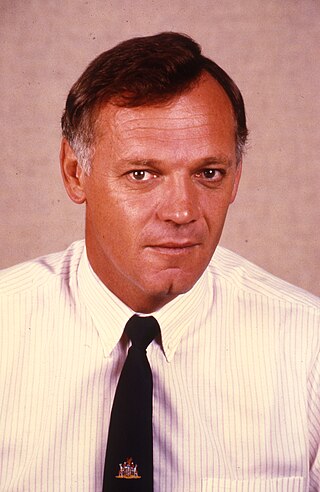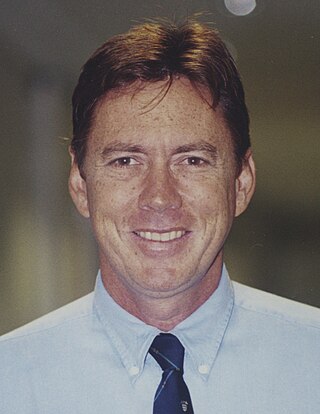Related Research Articles

A general election was held in the Northern Territory, Australia, on 18 August 2001. The centre-left Labor Party (ALP), led by Clare Martin, won a surprising victory over the Country Liberal Party (CLP). Before this, the CLP had held 18 out the 25 seats in the Northern Territory Legislative Assembly to the ALP's 7. After this election, the ALP held the majority with 13 seats to the CLP's 10, consigning the CLP to opposition for the first time since the Territory gained responsible government. Martin became Chief Minister, succeeding the CLP's Denis Burke.
The term swing refers to the extent of change in voter support, typically from one election or opinion poll to another, expressed as a positive or negative percentage point. For the Australian House of Representatives and the lower or unicameral houses of the parliaments of all the states and territories except Tasmania and the ACT, as well as Tasmania's upper house, Australia employs preferential voting in single-member constituencies. Under the full-preference instant-runoff voting system, in each seat the candidate with the lowest vote is eliminated and their preferences are distributed, which is repeated until only two candidates remain. While every seat has a two-candidate preferred (TCP) result, seats where the major parties have come first and second are commonly referred to as having a two-party-preferred (TPP) result. The concept of "swing" in Australian elections is not simply a function of the difference between the votes of the two leading candidates, as it is in Britain. To know the majority of any seat, and therefore the swing necessary for it to change hands, it is necessary to know the preferences of all the voters, regardless of their first preference votes. It is not uncommon in Australia for candidates who have comfortable leads on the first count to fail to win the seat, because "preference flows" go against them.
The Mackerras pendulum was devised by the Australian psephologist Malcolm Mackerras as a way of predicting the outcome of an election contested between two major parties in a Westminster style lower house legislature such as the Australian House of Representatives, which is composed of single-member electorates and which uses a preferential voting system such as a Condorcet method or IRV.

A general election was held in the Northern Territory on Saturday August 30, 1997, and was won by the incumbent Country Liberal Party (CLP).

A general election was held in the Northern Territory on Saturday 27 October 1990, and was won by the incumbent Country Liberal Party (CLP) under Chief Minister Marshall Perron.

A general election was held in the Northern Territory, Australia on Saturday 7 March 1987. Although the incumbent Country Liberal Party (CLP) won a majority under new leader Stephen Hatton, the party's vote was down almost 20 percentage points.

General elections were held in the Northern Territory of Australia on 9 August 2008. Of the 25 seats in the Legislative Assembly, 23 were contested; two safe Labor seats were uncontested. The incumbent centre-left Labor Party (ALP), led by Chief Minister Paul Henderson won a narrow third term victory against the opposition centre-right Country Liberal Party (CLP), led by Terry Mills. Labor suffered a massive and unexpected swing against it, to hold a one-seat majority in the new parliament.

A general election was held in the Northern Territory on Saturday 25 August 2012, which elected all 25 members of the Legislative Assembly in the unicameral Northern Territory Parliament.
The following is a pendulum based on the outcome of the 2010 federal election and changes since, including the redistributions of seats in South Australia and Victoria. It is a Mackerras pendulum, invented by psephologist Malcolm Mackerras, which works by lining up all of the seats held in Parliament according to the percentage point margin on a two-candidate-preferred basis. The two-party result is also known as the swing required for the seat to change hands. Given a uniform swing to the opposition or government parties in an election, the number of seats that change hands can be predicted. Swings are never uniform, but in practice variations of swing among the Australian states usually tend to cancel each other out. Seats are arranged in safeness categories according to the Australian Electoral Commission's (AEC) classification of safeness. "Safe" seats require a swing of over 10 per cent to change, "fairly safe" seats require a swing of between 6 and 10 per cent, while "marginal" seats require a swing of less than 6 per cent. The swings for South Australian and Victorian seats are notional, based on calculations by the AEC.
At the 2016 federal election of the 150 House of Representatives seats the Liberal/National Coalition won 76, a one-seat majority, Labor won 69 seats and crossbenchers won the remaining five. A redistribution in 2017/18 changed the representation entitlements. For the next election, the number of seats in the House will increase to 151, South Australia will lose a seat, Victoria and the Australian Capital Territory (ACT) will gain one seat each.
The Coalition won the 2013 federal election with 90 of 150 lower house seats on a current 17-seat, 3.65-point two-party swing, defeating the 6-year Labor government. Labor holds 55 seats while crossbenchers hold the remaining five. The Division of Fairfax was the last seat to be declared.
This is a Mackerras pendulum for the 2016 Australian federal election.
The Coalition won the 2016 federal election with a one-seat majority 76 of 150 lower house seats. Labor holds 69 seats while crossbenchers hold the remaining five.
The Labor party won the 2018 state election by winning 55 of the 88 lower house seats. The coalition won 27 seats while the Greens and independents won 3 each.
The Coalition won the 2019 federal election with a three-seat majority of 77 of 151 lower house seats. Labor holds 68 seats, and crossbenchers hold the remaining six.
The Mackerras pendulum was devised by the Australian psephologist Malcolm Mackerras as a way of predicting the outcome of an election contested between two major parties in a Westminster style lower house legislature such as the Australian House of Representatives, which is composed of single-member electorates and which uses a preferential voting system such as a Condorcet method or IRV.
The Australian Labor Party won the 2022 federal election, winning 77 of 151 seats in the House of Representatives. The Coalition holds 58 seats, and crossbenchers hold the remaining 16.
The Mackerras pendulum as a way of predicting the outcome of an election contested between two major parties in a Westminster style lower house legislature such as the Australian House of Representatives, which is composed of single-member electorates and which uses a preferential voting system such as a Condorcet method or instant-runoff voting.
The Mackerras pendulum as a way of predicting the outcome of an election contested between two major parties in a Westminster style lower house legislature such as the Australian House of Representatives, which is composed of single-member electorates and which uses a preferential voting system such as a Condorcet method or instant-runoff voting.
The Mackerras pendulum was devised by the Australian psephologist Malcolm Mackerras as a way of predicting the outcome of an election contested between two major parties in a Westminster style lower house legislature such as the Australian House of Representatives, which is composed of single-member electorates and which uses a preferential voting system such as a Condorcet method or IRV.
References
- ↑ Sakkal, Paul; Rooney, Kieran (14 November 2023). "Veteran Liberal Party MP Russell Broadbent quits party, moves to crossbench". The Sydney Morning Herald.
- 1 2 Newman, G; Kopras, A (4 November 1996). "Federal Elections 1996" (PDF). Background Paper 6 1996-97. Parliamentary Research Service. ISSN 1037-2938 . Retrieved 2024-01-09.